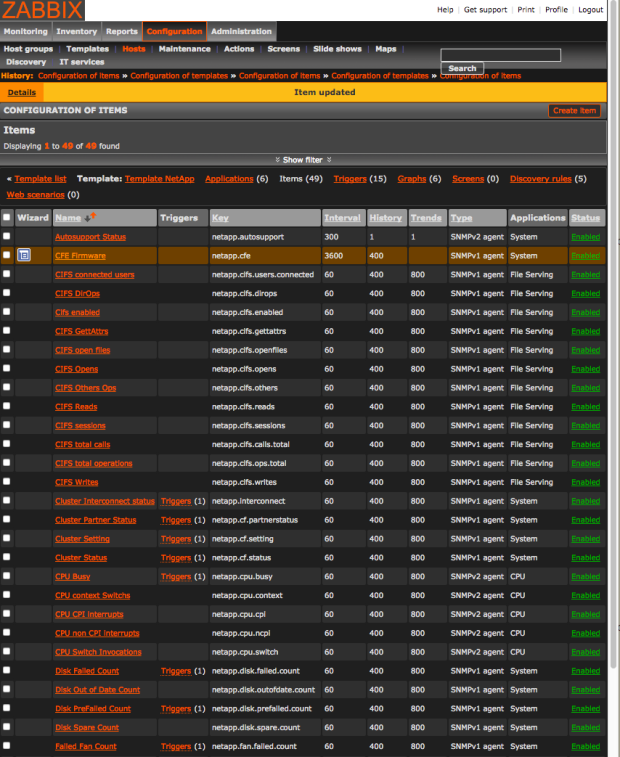Archive for November, 2016
Zabbix “became not supported” – solved
Posted by tomperrine in best practice, monitoring, System Administration on November 15, 2016
I think I’ve found one of the answers to a long-annoying Zabbix issue related to SNMP items “flapping” from “became supported” to “became not supported”.
TL;DR – using an SNMPv1 query against an SNMPv2 device will confuse Zabbix. You’ll see intermittent failures of different tests as the device flaps between OK and “unknown”. This can be hard to track down, as its’s not a hard repeatable failure. It’s not the only cause of this error, but fixing this will solve many of the issues.
Details:
While looking through our Zabbix server logs I found LOTS of these:
2031:20161027:111122.224 item "netapp-cluster.thuktun.com:netapp.disk.prefailed.count" became supported 2028:20161027:112119.172 item "netapp-cluster.thuktun.com:netapp.disk.prefailed.count" became not supported: SNMP error: (noSuchName) There is no such variable name in this MIB. 2030:20161027:120146.448 item "netapp-cluster.thuktun.com:netapp.disk.prefailed.count" became supported 2028:20161027:122120.026 item "netapp-cluster.thuktun.com:netapp.disk.prefailed.count" became not supported: SNMP error: (noSuchName) There is no such variable name in this MIB.
All of these referred to a NetApp in cluster mode, but I found a few similar messages related to some “NetBot” cameras around as well. Additionally, the actual test item varied; there were about 6 different tests that were all failing intermittently. The failing tests were:
- netapp.disk.prefailed.count
- netapp.disk.cfe
- netapp.disk.name
- netapp.disk.version
- netapp.disk.failed.count
- netapp.disk.spare.count
A few Google searches returned some items related to this kind of issue, back to 2013
- https://www.zabbix.com/forum/showthread.php?t=38912 (LenR mentions: “Should the items be zabbix-trapper instead of zabbix-agent? I think I’ve seen this with incorrectly defined zabbix-sender updated items.”
- https://www.zabbix.com/forum/showthread.php?t=22114 (This shows that this has been seen as far back as 2011)
- http://serverfault.com/questions/761645/zabbix-issue-with-lld-lots-of-became-supported-became-not-supported (“should be using Zabbix trapper instead of …)
All of these are talking about Zabbix trapper vs Zabbix agent, that is using the wrong type of check for the test item, but no mention of SNMP.
Let’s look at the Zabbix configuration. Are we using the trapper or the agent for these test items?
Note that the NetApp template doesn’t use the Zabbix trapper or agent, it uses SNMP. But, some tests are SNMPv1 and some are SNMPv2. This is likely due to the fact that some versions of NetApp have had varying support for v1 and v2 over the years, and whoever created the template originally started with just v1. Over the years, as more test items were exposed, new tests were added, but using SNMPv2 and the old tests were left at SNMPv1?
Interesting. All of the failing tests are using SNMPv1. Not all v1 tests are failing, but all failing tests are using v1. There’s nothing here about Zabbix trapper or the Zabbix agent, but there is a (potential) mismatch. This shouldn’t be a problem, but let’s find out.
Over the next few hours, as each failure showed up in the Zabbix logs, I switched that particular test to SNMPv2. After being changed, that test never again “flapped”.
It seems that the keys to solving this were:
- LenR’s comment from 2013 about incorrectly defined items (although he was mentioning the zabbix-sender, not SNMP)
- Realizing it wasn’t a problem with the trapper vs agent, or an incorrect item definition in the agent, but that it was a mismatch in the server’s definition in the test item.
- That SNMPv1 and V2 are being treated differently in the Zabbix server, and that usually doing a v1 test against a v2 device will usually work, but not always.
- The “soft” failure of the v1 test against the v2 device “presents” as a MIB problem (“SNMP error: (noSuchName) There is no such variable name in this MIB.”), not a protocol failure.
I changed all of the failing NetApp tests to SNMPv2 last week. Since then all the tests that were changed from SNMPv1 to SNMPv2 have been fine. There have been none of these errors in the logs for 5 days.
Next: What about those NetBotz? Or maybe Zabbix meets IPv6 🙂
IPv6 at AWS – Route53
Posted by tomperrine in best practice, IPv6, ISPs, System Administration on November 11, 2016
Hooray! AWS users can now serve their DNS info over IPv6. You could serve AAAA records before, but only over IPv4.
This finally gives AWS customers a way to deal with IPv6-only customers (as are appearing in Asia), who might have otherwise had to depend on ISP proxies or CGN (Carrier Grade NAT), host their DNS elsewhere, or be unable to reach services hosted in AWS.
IPv6 – now from COX (San Diego)!
Posted by tomperrine in IPv6, personal IT, System Administration on November 9, 2016
As you recall, I’ve been lamenting the lack of direct IPv6 via my local ISP (COX) since 2013.
It seems that some time in the past 3 months, they silently enabled IPv6 in my area! I was preparing to reconfigure my tunnel from tunnelbroker and decided to “just check”. Cox is now correctly(!) serving IPv6.
I had to turn off my Hurricane Electric tunnel a few months ago, as Netflix began blocking as many tunnel services as they could, over geo-location “issues”.
I was able to set my Apple Airport Extreme to “auto configure” for IPv6, and I’ve got proper addresses, routers and even DNS over IPv6.
Thanks Cox!

